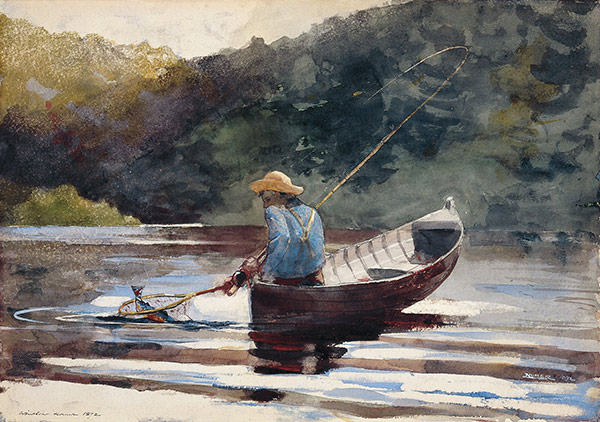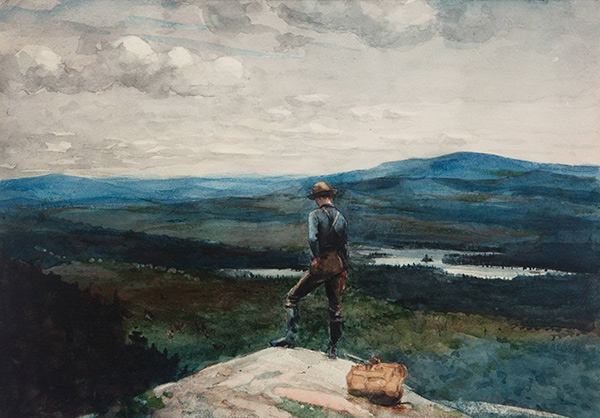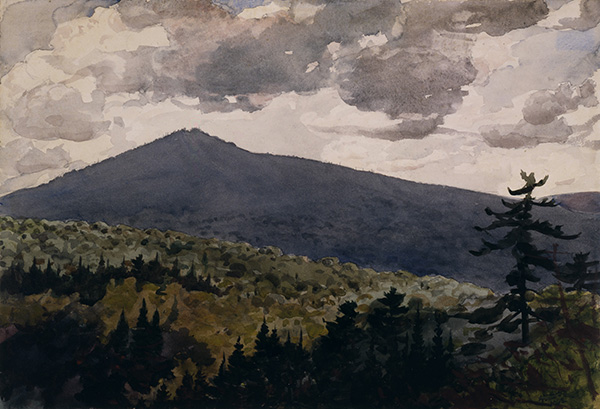Subtotal: $
Checkout
My Neck of the Woods
The Adirondack Park, a mixture of strongly protected public and private lands, is a great example of how humans can dwell in the natural world in a way that benefits both.
By Felix James Miller
July 19, 2024
Across the street from the hospital where my second child was born, there is a small picnic area my one-year-old son and I would go during my wife’s appointments. This is hardly surprising – picnic areas are quite sensible things to have near hospitals. What is surprising, though, is what surrounds my son while he picks up leaves and excitedly brings them to me to inspect: a picturesque lake and an untrammeled forest. As my son and I play together, we are surrounded by the 6.1 million acres of forest preserve known as the Adirondack Park.
The Adirondack Park, which is valued so highly as to be explicitly protected by New York State’s constitution, is unique in the United States, being about half publicly owned forest preserve and half privately owned land. This means that the park’s 132,000 year-round residents and 200,000 seasonal residents are surrounded by nearly untouched nature. The park also welcomes around eight million visitors each year to enjoy hiking, boating, skiing, or simply existing in a place of beauty.
As a child, I never really reflected on what a blessing it was to spend so much of my time in the Adirondacks. Living within and close to the park has profoundly formed me as a person, cultivating a receptivity to beauty, a trust in God’s goodness, and a desire for the kind of peace that immersion in nature affords.
Critics of conservation efforts often place economic interests above the health of the natural world. The Adirondack Park, with its integration of protected lands and human habitation, presents an alternative that suggests these two concerns need not be entirely at odds. A look at the history of the park and how humans dwell in it can inform our relationship to creation, regardless of where we call home.
While the Adirondack Park only became a legal reality in 1892, the area (named for the over 100 mountains it boasts) has held a special place in the hearts of Americans for much longer. Starting in the 1820s, the work of artists such as Thomas Cole, Winslow Homer, and Rockwell Kent began drawing attention to the natural beauty of the area, showcasing the autumnal colors and the clarity of the light, and authors like Joel Tyler Headley began to write about the area as well. But it wasn’t until the middle of that century that the Adirondacks would become the center of national conversation owing to the passion shown by a rather eccentric preacher.
William H. H. “Adirondack” Murray was a Congregational minister and pastor of Park Street Church in Boston for six years starting in 1868. That same year, he published his best-known book, Adventures in the Wilderness: Or, Camp-life in the Adirondacks. In this work, which is half guidebook and half paean to the area, the winsome writer shared his love for the Adirondacks, arguing that time in nature has essential physical and spiritual benefits. As a result of the book’s success, people began swarming the Adirondacks. Many of these people were extremely unprepared for the realities of camping, thus gaining the nickname “Murray’s fools.”

Winslow Homer, Boy Fishing, watercolor on paper, 1892.
At the time, mining and logging industries were running roughshod over much of the Adirondacks. A decade and a half after the publication of Murray’s book, many parts of the area were so thoroughly stripped of their trees that loggers completely abandoned them. This led not just to the loss of natural beauty but to practical problems such as erosion and flooding.
Around the same time as Murray was helping America to fall in love with the Adirondacks, another man, Verplanck Colvin, began to document the damage logging and other industries were doing to the area. After decades of work, Colvin and other activists convinced the New York state legislature to establish a forest preserve in 1885. The law famously states that the preserve “shall be forever kept as wild forest lands,” and the phrase “forever wild” has since become central to locals and visitors’ conception of the Adirondacks. In 1892, the area officially became the “Adirondack Park,” and the New York state government has protected it fiercely. Indeed, since 1894, it has been illegal to cut down even a single tree on public land in the park.
What most distinguishes the Adirondack Park is the fact that it is not just an untouched wilderness; the park is also a place where people live and work.
As a boy, I had no interest in learning about this history. I took the park as a given, like the sun rising in the morning and dinner appearing on the table in the evening. But now I realize that this story matters. It was not a foregone conclusion that the park would come to exist. The land could have continued to be stripped until it was ugly and barren. Instead, Murray, Colvin, and many like them have helped people to fall in love with the natural beauty of the Adirondacks and to want to protect them. Activists worked to do the research and lobbying necessary to convince the state legislature that something needed to be done. Finally, the members of the legislature took the bold step of trying a unique experiment to foster appreciation of the majesty of creation in the Adirondacks.
That isn’t to say that the path since has always been smooth. The history of the park includes many stories of people breaking the letter or the spirit of the laws that protect the park. In 1971, the Adirondack Park Agency (APA) was formed to enforce the many restrictions that ensure the park’s continued existence. At the time, there was pushback from many locals, who saw the APA as an affront to their rights as private citizens and property owners. This was quite understandable; by suddenly enforcing the law strictly, the APA inarguably forced many people to change aspects of their lives, sometimes drastically. Over time, though, attitudes have changed, and many – perhaps most – of the park’s residents now see themselves as allies of the APA and stewards of the land.
This shift is in part the result of the fact that many of today’s residents grew up in a world where they saw the APA protecting the places they love. Additionally, many non-natives have chosen to live in or near the park precisely because they trust that the places they love will be protected. Russ Kinyon, a Michigan native who has worked in economic development leadership in the Adirondack Park and surrounding area for seven years, says he has made promoting and defending the area’s peace and beauty a vocation.
While in college, Kinyon took an environmental biology course, with no idea that it would change the course of his life. It forced him to think about what makes development sustainable and, more broadly, what our proper relationship to the earth is, an issue he considers central to his work. Kinyon sees the primary aim of his work (and economic development in general) as enhancing the lives of residents and visitors, promoting their flourishing by enabling them to live and work in ways that support the community and the natural environment. As he puts it, “the purpose of economic development is to enhance a place. We find the good in a place and help people to nurture it.”

Winslow Homer, The Ranger, Adirondacks, watercolor on paper, ca. 1892.
Kinyon speaks about his own love for the beauty of the park. A Christian, he tells me that “it’s been a huge part of my spiritual journey to just bask in that nothingness, that quiet, to just sit by a pond in stillness.” While we speak, he lovingly describes Mountain Pond, a small body of water in the hamlet of Paul Smiths. This is one of thousands of such ponds in the Adirondacks. When asked what makes it special to him, he says that, though it’s just an eighth of a mile from the road, Mountain Pond feels like its own world. The peace of the water allows him space to “listen, reflect on life, sit with uncomfortable thoughts like grief and sadness, and ponder ways to grow and all that we have to work through with God.”
This experience is echoed by many who try to articulate the park’s importance. As the environmentalist Bill McKibben puts it, “You go to Alaska and you see what deep, deep wilderness looks like. But the Adirondacks is the Alaska of redemption. A place that was cut down from stem to stern, but allowed to recover. It’s a kind of second-chance Eden, and there aren’t other places like that on the earth.”
What most distinguishes the Adirondack Park, though, is the fact that it is not just an untouched wilderness; the park is also a place where people live and work. Though much of the land is sacrosanct, the majority is actually privately owned.
In his irreverent but powerful book, The Lost Continent: Travels in Small-Town America, Bill Bryson describes coming to the edge of a national park and being struck by how, as soon as he left its borders, “suddenly all was squalor again.” He was surrounded by fast-food restaurants, worn-down homes, and pot-holed roads. As he put it, “America has never quite grasped that you can live in a place without making it ugly, that beauty doesn’t have to be confined behind fences, as if a national park were a sort of zoo for nature.”
The Adirondack Park, conversely, places a certain onus on those who live there to keep their surroundings beautiful and healthy, though this is a burden many bear with joy. Bob Eckert and Sheila Delarm are a married couple living on fifty acres in the Adirondack Park who have dedicated much of their lives to protecting the ecosystem on their property, caring for it in ways that have, not incidentally, also improved the beauty of the space. The couple has a strong entrepreneurial streak, running three businesses from their land, always trying to do so in ways that are attentive to the place’s needs.
They are grateful for the legal structures in place that protect the land. Their land has been a certified tree farm for around forty years, which allows them to sell firewood and maple syrup. They began this business in part precisely because of their desire to care for the land in a responsible way, as a number of government resources are available to registered tree farms aiming to be ecologically responsible.
While Delarm, a native Adirondacker, loves introducing people to the park, she worries about the impact tourism can have. There are many visitors who recognize what a special place the park is and are careful to treat the area well, but she also sees many who approach the land as a sort of playground, failing to recognize the responsibilities incumbent on everyone within the park. For her, the solution to this is twofold: connection and education.
Delarm describes how she always needs “a quiet place to connect,” and how important she believes this is for everyone. This connection is not just with nature, but with our selves and the transcendent. She says it is especially powerful to return to the same place again and again – like Kinyon’s visits to Mountain Pond. It’s with repeated visits that we begin to connect with nature as a living whole, Delarm says; only then do we notice the mushroom that just popped up in the last week, connected to a vast underground network.
Experiences of beauty can be morally and spiritually transformative, or even just comforting in times of tribulation.
Her husband, Bob Eckert, has seen the on-the-ground importance of this kind of connection in his work as a therapist for troubled teens who come to spend time in the Adirondack wilderness. Some of the young people with whom he has worked had bullied or even attacked others, while some engaged in self-harming behaviors. When placed in a natural context, many of the teenages also showed a disregard for the natural world, and Eckert argues this wasn’t coincidental. In each of these cases, Eckert believes, they “felt disconnected from the thing they were damaging.” He insists that cultivating a sense of connection with nature can help spur real moral growth, something he has seen first hand.
Today, the couple also operates the Adirondack Adventure Base on their land, hosting visitors to the area and encouraging them to experience the Adirondack Park through hiking, boating, and other outdoor activities. The couple believes that time in the park – like any time in nature – is a gift, but it is one that implicitly calls visitors to become more aware of both themselves and their surroundings. As Delarm puts it, “Wherever the space is, we need to learn, first, to be in it, second, to respect it, and then, [finally,] to protect it.” The best conservation begins with a connection fostered by sustained or repeated presence in a place.
This is part of what makes the park so special. By its very structure, the Adirondack Park encourages residents, neighbors, and visitors to be present in beautiful natural spaces. Even a routine drive through the park can help inculcate this kind of receptivity. When driving through the Adirondacks, I travel through miles and miles of forests. There is one body of water, Barnum Pond, that might be my favorite. I’ve hiked through the forest to the pond dozens of times since childhood, and I even took my older son there for his first hike when he was about four months old. I can’t go to Barnum Pond without feeling two things: the presence of hundreds of thousands of plants and animals living and growing, and peace.
But part of what I love about this particular pond is one side’s proximity to the road. When driving down Route 30, after miles of forests, the road begins to curve, and one side opens up, revealing a majestic body of water – more lake than pond. The road hugs the water, never more than about ten feet from it. I always slow down. Even when I’m driving to a mundane destination like a doctor’s appointment, I am confronted with the pond’s striking beauty and reminded of hikes I’ve been on there and the promise of transcendent peace they provide.
In recent years, identifying as “spiritual but not religious” has gained traction. There are certain stereotypes about people who refer to themselves this way, one being that they “find God in sunsets.” Despite the fact that this hackneyed phrase is often mocked, experiences of beauty can be morally and spiritually transformative, or even just comforting in times of tribulation. This is true whether or not a person has a sophisticated theological understanding of God. Indeed, for many in our dogmatically relativistic age, appeals to truth and goodness fall flat, whereas natural beauty compels them to believe in something beyond the material world.
Even many irreligious defenses of the Adirondack Park acknowledge this. As historian Philip Terrie describes it, the park’s status is “really a spiritual issue for a lot of people. The idea of a nature that is not tampered with by people is spiritually significant to a lot of people, including myself. And the constitution of the State of New York makes it official.”
The Adirondack Park’s legal structure is unique, but that doesn’t mean that we can’t learn from its successes no matter where we live. Delarm and Eckert described how, while travelling in dozens of states and foreign nations, they have been able to find what they refer to as “little nuggets of the Adirondacks,” places where natural beauty springs up in the midst of human hustle and bustle, reminding us of the vast creation that sustains us.

Winslow Homer, Burnt Mountain, watercolor and graphite on paper, 1902.
While these nuggets can be dramatic (think of New York City’s Central Park), they can so small that they are easy to miss. At a difficult time in my life, I found one in my own home. Living in Washington, DC, for graduate school coursework, I experienced a period of spiritual dryness and social disconnection. I attended Mass regularly, spent time in prayer every day, and had friends nearby, but I often felt that my daily life was filled with fruitless endeavors.
I was given a houseplant, a small succulent, by someone who had gotten it as a wedding favor and didn’t want to keep it. As far as I can remember, I hadn’t had a plant of my own since childhood, when I tended some morning glories in my father’s garden, and I had never particularly been attracted to getting one. For whatever reason, though, I strove to take good care of the succulent. Over time, I developed an affection for the plant, giving it a nickname and regularly talking about its growth with one of my housemates. Tending to this plant gave me a sense of purpose in the dark days of graduate school, and even though it was small, it was a piece of something so much bigger: not just a garden or forest or even the whole Adirondacks but a world of beauty given to humankind to steward.
Years later, being handed leaves by my excited son in the middle of the Adirondack Park, I am reminded of an anecdote relayed by John Green in his book The Anthropocene Reviewed. He describes bringing his two-year-old son on a hike and trying to get him to notice the majestic landscape that lay before them. His son, though, was disinterested in the view and instead fascinated by an oak leaf he had grabbed, repeatedly saying “weaf!” to his father. Green writes:
I wanted to explain to him that you can see a brown oak leaf anywhere in the eastern United States in November, that nothing in the forest was less interesting. But after watching him look at it, I began to look as well, and I soon realized it wasn’t just a brown leaf. Its veins spidered out red and orange and yellow in a pattern too complex for my brain to synthesize, and the more I looked at that leaf with Henry, the more I was compelled into an aesthetic contemplation I neither understood nor desired, face-to-face with something commensurate to my capacity for wonder.
There is so much in nature at which to wonder. In the Compendium of Theology Thomas Aquinas considers why the natural world shows such astonishing diversity. His answer is that God uses his creation to express himself. No finite creature could fully show God’s infinite perfection, but with countless people, plants, animals, and stars, each a window into God’s beauty, we begin to get a sense of it. As Aquinas puts it, “There had to be diversity in the things produced by God, in order that the divine perfection might in some fashion be imitated in the variety found in things.”
Daily life need not be separated from the beauty of the natural world. Whether we’re engaged in conservation or city planning, gardening or just tending to a single plant, the Adirondack Park should inspire us to care for the world God has given us, which, so long as we are open, points us back to him.
Already a subscriber? Sign in
Try 3 months of unlimited access. Start your FREE TRIAL today. Cancel anytime.






